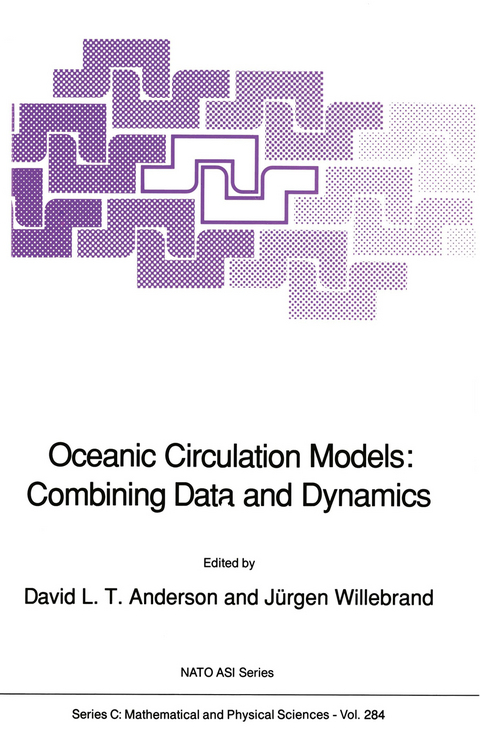
Oceanic Circulation Models: Combining Data and Dynamics
Springer (Verlag)
978-94-010-6946-5 (ISBN)
Tracer Inverse Problems.- 1. Introduction.- 2. Interpolation and Map Making.- 3. Simple Estimation.- 4. Using Steady Tracers.- 5. Time Dependent Problems.- Appendix. Some Notes on the History of Inverse Methods in Ocean Circulation Problems.- A Geometrical Interpretation of Inverse Problems.- 1. The Overdetermined Case.- 2. The Underdetermined Case.- 3. The Singular Value Decomposition (SVD).- Determining Diffusivities from Hydrographic Data by Inverse Methods with Applications to the Circumpolar Current.- 1. Introduction to Ill-posed and Noisy Problems.- 2. The Physical Model.- 3. The Inverse Model.- 4. Examples: Circulation and mixing in the Southern Ocean.- Ocean Acoustic Tomography: a Primer.- 1. Introduction.- 2. Elementary Hydrodynamics and Acoustics.- 3. Ocean Sound Speed Distribution.- 4. Rays and Modes.- 5. Capsule Description of the Tomographic Method.- 6. A Simple Ray Example.- 7. Notes on Hardware Limitations and Observational Errors.- 8. Inversions.- 9. Some Results and Future Plans.- 10. Conclusions.- 11. Literature.- The Circulation in the Western North Atlantic Determined by a Nonlinear Inverse Method..- 1. Introduction.- 2. A Nonlinear Inverse Formalism.- 3. The Circulation in the Western North Atlantic.- Altimeter Data Assimilation into Ocean Circulation Models — Some Preliminary Results.- 1. Introduction.- 2. A Dynamic Initialization Scheme.- 3. Time and Space Dependence of the Observations.- 4. Geosat Assimilation in the Agulhas Retroflection Region.- 5. Discussion.- Assimilation of Data into Ocean Models.- 1. Introduction.- 2. Theory.- 3. Applications.- 4. Conclusions.- Driving of Non-linear Time-dependent Ocean Models by Observation of Transient Tracers — a Problem of Constrained Optimisation.- 1. Introduction.- 2. A Control Problem.- 3. AnElegant and Efficient Way to Calculate the Gradient of the Cost Function.- 4. The Ocean Model and its Adjoint.- 5. Results.- 6. Model Parameters as Control Variables.- 7. Sensitivity.- 8. Conclusions.- Assimilation of XBT Data Using a Variational Technique.- 1. Introduction.- 2. Implementation of Variational Assimilation Using Lagrange Multipliers.- 3. Results.- The Role of Real-Time Four-Dimensional Data Assimilation in the Quality Control, Interpretation, and Synthesis of Climate Data.- 1. Introduction.- 2. The Importance of Accurate Data Assimilation for NWP.- 3. The Analysis Module.- 4. Non-linear Normal Mode Initialization.- 5. The Forecast Model.- 6. Quality Control and Data Monitoring.- 7. The Value and Limitations of Global NWP Datasets for Climate Studies.- 8. Inversion and Quality Control of Remotely Sensed Data.- 9. Real-Time Integration and Synthesis of WCRP Observations.- to Chemical Tracers of the Ocean Circulation.- 1. Dimensional Analysis of a Tracer Conservation Equation.- 2. General Information on Tracers of Ocean Circulation.- 3. Surface Boundary Conditions.- 4. Mixing in the Deep Ocean.- 5. Conclusion.- On Oceanic Boundary Conditions for Tritium, on Tritiugenic 3He, and on the Tritium-3He Age Concept.- 1. Introduction.- 2. Tritium Ocean Surface Boundary Condition.- 3. Separation of Tritiugenic 3He.- 4. The Tritium-3He Age Concept.- 5. Tritium-3He Age Distributions on Isopycnal Surfaces in the Lower Northeast Atlantic Main Thermocline.- 6. Conclusions.- Ocean Carbon Models and Inverse Methods.- 1. Introduction.- 2. Diagnostic Equations.- 3. Parameterization of the Model: Methodological Issues for Inverse Methods.- 4. Some Preliminary Experiments.- Model of the Nutrient and Carbon Cycles in the North Atlantic. An Application of Linear Programming Methods.- 1. Introduction.- 2. The Model.- 3. Results for the ‘Inorganic’ Case.- 4. Results for the ‘Inorganic and Organic’ Case.- 5. Summary.- The Design of Numerical Models of the Ocean Circulation.- 1. Fundamentals of Model Design.- 2. Stability.- 3. Stability of Advective Schemes and Vertical Coordinates.- 4. The Application of Ocean General Circulation Models.- Instabilities and Multiple Steady States of the Thermohaline Circulation.- 1. Introduction.- 2. Box Models.- 3. 2-D Model.- 4. GFDL Model.- 5. Conclusions.- Subgridscale Representation.- 1. Introduction.- 2. Organization.- 3. Quasi-horizontal Stirring.- 4. Quasi-vertical Mixing.- 5. Benthic Boundary Processes.- Appendix A.- Appendix B.
| Reihe/Serie | NATO Science Series C ; 284 |
|---|---|
| Zusatzinfo | XXIII, 605 p. |
| Verlagsort | Dordrecht |
| Sprache | englisch |
| Maße | 155 x 235 mm |
| Themenwelt | Mathematik / Informatik ► Mathematik ► Analysis |
| Naturwissenschaften ► Geowissenschaften ► Geografie / Kartografie | |
| Naturwissenschaften ► Geowissenschaften ► Geologie | |
| Naturwissenschaften ► Geowissenschaften ► Hydrologie / Ozeanografie | |
| Naturwissenschaften ► Geowissenschaften ► Meteorologie / Klimatologie | |
| ISBN-10 | 94-010-6946-8 / 9401069468 |
| ISBN-13 | 978-94-010-6946-5 / 9789401069465 |
| Zustand | Neuware |
| Haben Sie eine Frage zum Produkt? |
aus dem Bereich


